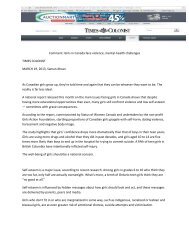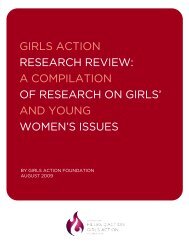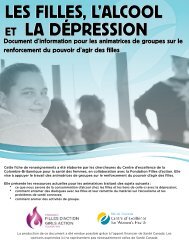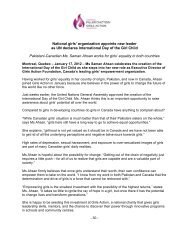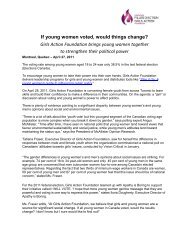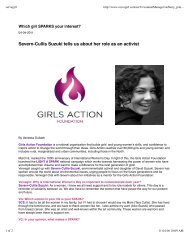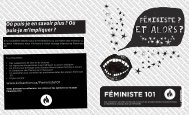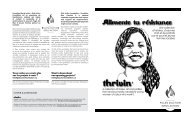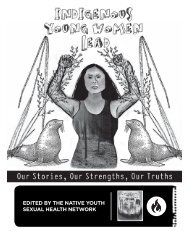physical activity - Girls Action Foundation
physical activity - Girls Action Foundation
physical activity - Girls Action Foundation
Create successful ePaper yourself
Turn your PDF publications into a flip-book with our unique Google optimized e-Paper software.
GIRLS, PHYSICAL<br />
ACTIVITY CULTURE<br />
AND<br />
Tools for Facilitators of <strong>Girls</strong>’ Empowerment Groups<br />
This information sheet has been developed by researchers at the British Columbia Centre for<br />
Excellence for Women’s Health, in collaboration with <strong>Girls</strong> <strong>Action</strong> <strong>Foundation</strong> and the Canadian<br />
Association for the Advancement of Women and Sport and Physical Activity (CAAWS). It is<br />
intended to support the work of facilitators of girls’ empowerment groups.<br />
It presents current resources for facilitators on:<br />
• What we know about girls’ <strong>physical</strong> <strong>activity</strong> and healthy living<br />
• How to create fun, safe, culturally relevant <strong>physical</strong> <strong>activity</strong> programs for girls<br />
• Starting conversations and sharing materials about <strong>physical</strong> <strong>activity</strong> with girls<br />
Production of this document has been made possible through a financial contribution from Health Canada.<br />
The views expressed herein do not necessarily represent the views of Health Canada.
<strong>Girls</strong> and <strong>physical</strong> <strong>activity</strong>: Why we need to support it<br />
Being active for at least 60 minutes daily can help teens (12-17 years):<br />
• Improve their health<br />
• Do better in school<br />
• Improve their fitness<br />
• Grow stronger<br />
• Have fun playing with friends<br />
• Feel happier<br />
• Maintain a healthy body weight<br />
• Improve their self-confidence<br />
• Learn new skills<br />
Source: The Canadian Society for Exercise Physiology (CSEP) 1<br />
PATTERNS AND TRENDS IN GIRLS’ AND YOUNG WOMEN’S PHYSICAL ACTIVITY<br />
• In the 2007 to 2009 Canadian Health Measures Survey, only 4% of girls (compared to 9% of<br />
boys) achieved the recommended levels of daily <strong>physical</strong> <strong>activity</strong> 2 .<br />
• Only 70% of girls participated regularly in sport during the previous 12 months, compared to<br />
81% of boys 3 .<br />
• <strong>Girls</strong> become less active as they transition from childhood to adolescence. Between ages 5-12,<br />
56% of girls are not active enough. In the teen years, it’s 70% 4 .<br />
• Beginning at the age of 12, girls’ involvement in <strong>physical</strong> <strong>activity</strong> declines steadily until only 11%<br />
are still active by age 16-17 5 .<br />
• Only 10% of female students in BC enroll in <strong>physical</strong> education when it becomes elective 6 .<br />
• <strong>Girls</strong> and young women who are <strong>physical</strong>ly active or involved in sports are less likely to use<br />
tobacco 7 .<br />
• <strong>Girls</strong> and women from ethnic communities are the most underrepresented in the Canadian<br />
sport and recreation system 8 .<br />
• The odds of weekly sports participation are almost 80% higher for Aboriginal boys than girls 9 .<br />
• Aboriginal children who take part in extracurricular activities, such as cultural activities are<br />
more likely to take part in sports. Four in ten Aboriginal children participate in cultural<br />
activities 9 .<br />
• Neighbourhood safety impacts girls and women’s <strong>physical</strong> <strong>activity</strong> and there is a need for<br />
strategies that ensure that neighbourhoods are safe for walking, cycling, and other forms of<br />
<strong>physical</strong> <strong>activity</strong>.<br />
2
INACTIVITY AND SEDENTARY BEHAVIOUR<br />
• Sedentary behaviour plays a larger role than <strong>physical</strong> <strong>activity</strong> in predicting overweight among<br />
girls 10 .<br />
• It has been estimated that 58% of girls (grades 5 to 8) spend more than 2 hours per day talking<br />
on the phone, texting, or instant messaging 11 .<br />
• <strong>Girls</strong> ages 10-11 from low-income neighbourhoods are two to four times more likely than their<br />
counterparts from more affluent neighbourhoods to be overweight or obese 12 .<br />
• Low self-esteem and weight concerns are strong predictors of smoking initiation in young<br />
women 13,14 , factors which are also associated with in<strong>activity</strong> 15,16 .<br />
• Children’s television time has been linked to mothers’ perceptions of neighbourhood safety<br />
where children in the least safe neighbourhoods tend to spend more time watching TV 17 .<br />
NO NEED TO BE AN ATHLETE<br />
To integrate <strong>physical</strong> <strong>activity</strong> into your empowerment programs for girls, you do not need to be an<br />
expert, in perfect shape, sporty or an athlete. Increasing <strong>physical</strong> <strong>activity</strong> opportunities can be as easy<br />
as integrating active games or ice breakers, walking instead of taking transit, or watching an<br />
instructional video (e.g. yoga, aerobics, zumba). Being willing to try something new yourself is a great<br />
way to show girls you do not need to be a pro, or an athlete or ‘super-fit’ to have fun and be active!<br />
Included within this resource are projects to know about, resources to try and organizations to get<br />
involved with to support girls’ <strong>physical</strong> <strong>activity</strong> and healthy living.<br />
CANADIAN PHYSICAL ACTIVITY GUIDELINES<br />
According to 2013 Canadian Physical Activity and Sedentary Behaviour Guidelines, girls (5-11 years)<br />
and young women (12-17 years) should accumulate at least 60 minutes of moderate-to-vigorousintensity<br />
<strong>physical</strong> <strong>activity</strong> daily. This should include: vigorous-intensity activities (which causes sweat<br />
and being ‘out of breath’) at least 3 days per week and activities that strengthen muscle and bone at<br />
least 3 days per week. More daily <strong>physical</strong> <strong>activity</strong> provides greater health benefits 18 .<br />
Sedentary behaviour should be minimized, such as prolonged sitting.<br />
!<br />
Source: The Canadian Society for Exercise Physiology (CSEP) Canadian Physical Activity Guidelines and Canadian<br />
Sedentary Behaviour Guidelines (available in French, English Inuktitut and Inuinnaqtun)<br />
3
How you can support girls to stay active<br />
<strong>Girls</strong>’ group facilitators can support girls’ well-being by integrating <strong>physical</strong> <strong>activity</strong> into girls’ groups in<br />
ways such as:<br />
ü<br />
ü<br />
ü<br />
Limiting sedentary behaviour (sitting for long periods, etc.)<br />
Active play (create <strong>physical</strong> <strong>activity</strong> opportunities through games, visiting community facilities,<br />
or inviting a guest instructor to teach a new sport or <strong>physical</strong> <strong>activity</strong>)<br />
Active discussion (e.g. go for walk while discussing an issue or topic)<br />
CAAWS’ ON THE MOVE INITIATIVE – GETTING GIRLS ACTIVE!<br />
The Canadian Association for the Advancement of Women and Sport and Physical Activity (CAAWS) is<br />
a national non-profit organization dedicated to increasing opportunities for girls and women to<br />
participate and lead in sport and <strong>physical</strong> <strong>activity</strong> in Canada.<br />
On the Move is CAAWS’ national initiative designed to increase opportunities for inactive girls and<br />
young women (ages 9-18) to participate in sport and <strong>physical</strong> <strong>activity</strong>. Through On the Move, CAAWS<br />
works with program leaders and decision makers to create positive programs and inclusive<br />
environments that support girls’ participation in sport and <strong>physical</strong> <strong>activity</strong>. On the Move provides a<br />
number of practical resources designed to support quality program development and implementation,<br />
and CAAWS has led projects examining the sport and <strong>physical</strong> <strong>activity</strong> experiences of Aboriginal,<br />
newcomer, and racialized girls and young women. The On the Move Top 10 Success Factors (see insert,<br />
next page), provide a list of key program characteristics to help make your program or event, a<br />
success!<br />
4
CAAWS’ ON THE MOVE TOP 10 SUCCESS FACTORS<br />
1. Emphasize Fun! – Physical <strong>activity</strong> should be a fun experience. Create a social<br />
environment that emphasizes participation over skill and celebrates personal bests and<br />
accomplishments.<br />
2. Introduce a Variety of Physical Activities – <strong>Girls</strong> and young women are often unaware of<br />
the many <strong>physical</strong> activities available. Integrate traditional and non-traditional activities,<br />
and promote opportunities within your community by visiting pools, arenas, courts,<br />
climbing gyms and parks.<br />
3. Allow Input into Program Design – Value the interests and ideas of girls and young<br />
women. Ask what sports and <strong>physical</strong> activities they are interested in, and create<br />
opportunities for them to plan and make decisions.<br />
4. Provide Female-Only Opportunities – Many females feel uncomfortable or are restricted<br />
from participating in front of males for cultural or religious reasons. Provide girls and<br />
young women with opportunities to participate in <strong>physical</strong> <strong>activity</strong> in their own way.<br />
5. Create a Positive Environment – Create a safe and inclusive environment. Think about<br />
your own and others’ actions, and listen to participants’ (and their parents’) concerns<br />
and needs. Consider language, visual images, <strong>physical</strong> environment, policy and practice.<br />
6. Teach the Basics – Investing time in developing girls’ and young women’s <strong>physical</strong><br />
literacy and fundamental movement skills will help them build a foundation for life-long<br />
active living.<br />
7. Move More – The Canadian Physical Activity Guidelines recommend 60 minutes of<br />
moderate or vigorous <strong>physical</strong> <strong>activity</strong> per day. Ensure girls and young women are<br />
actively engaged to contribute to the health outcomes of your program.<br />
8. Be a Positive Role Model – Try new activities, demonstrate healthy, active living, and<br />
respect participants’ needs, interests and experiences. Have fun with participants, and<br />
cheer them on. A connection with the program leader will support girls’ and young<br />
women’s regular participation.<br />
9. Transportation – Deliver programs at schools or in target neighbourhoods to increase<br />
accessibility. Provide, coordinate or support transportation when necessary (e.g. pick-up<br />
participants in your organization’s van, organize a walking school bus, provide bus<br />
tickets).<br />
10. Food – A healthy snack will fuel girls’ and young women’s participation, and provides an<br />
opportunity for tasting experiences or educational sessions supporting healthy eating<br />
choices.<br />
Source: CAAWS (2012).<br />
On the Move Top Ten Success Factors. Available online, see CAAWS website, 'publications’: http://www.caaws.ca/<br />
4
CAAWS Reports and Publications related to <strong>Girls</strong><br />
Physical Activity<br />
(Available in English and French online, see CAAWS website, click on ‘Publications’: http://www.caaws.ca/)<br />
• On the Move Handbook<br />
Provides a step by step process for creating a fun, female only <strong>physical</strong> <strong>activity</strong> program, with lots of<br />
background information, success stories, and tips.<br />
• Making Healthy Connections with Racialized Communities: <strong>Girls</strong> and Young Women’s Experiences<br />
with Sport, Physical Activity and Healthy Living<br />
Discusses the unique sport and <strong>physical</strong> <strong>activity</strong> needs, interests and experiences of girls and young women<br />
from diverse ethno-cultural communities, shares insights and experiences from community and program<br />
leaders, and provides recommendations to enhance program and service delivery.<br />
• Aboriginal On the Move After School Success Stories<br />
In 2010-2012, CAAWS partnered with the National Association of Friendship Centres and five member Centres<br />
to support the development and delivery of active after school programs for Aboriginal girls and young<br />
women.<br />
• In Her Voice: An Exploration of Young Women’s Sport and Physical Activity Experiences<br />
Provides insight into the sport and <strong>physical</strong> <strong>activity</strong> needs, interests and experiences of girls and young<br />
women (ages 13-18) based on focus group discussions. Practical recommendations support the creation of<br />
positive programs and inclusive environments.<br />
• Actively Engaging Women and <strong>Girls</strong>: Addressing the Psycho-Social Factors<br />
Provides background information and recommendations to address the psycho-social factors that influence<br />
female athlete development, leadership and life-long participation in sport and <strong>physical</strong> <strong>activity</strong>. A supplement<br />
to Canadian Sport for Life (CS4L), a movement to improve the quality of sport and <strong>physical</strong> <strong>activity</strong> in Canada.<br />
A number of targeted supplements with practical recommendations are available, including:<br />
• Recommendations for Community Program Leaders and Coaches<br />
• Recommendations for Educators and School Administrators<br />
• Recommendations for Families and Caregivers<br />
• Active After School Programs for <strong>Girls</strong> and Young Women: Policy and Recommendations<br />
Describes a vision and strategic directions for quality active after school programs for girls and young women.<br />
• Active & Free: Young Women, Physical Activity and Tobacco<br />
A practical tool to support your work towards encouraging a healthy lifestyle for young women by keeping<br />
them <strong>physical</strong>ly active and tobacco-free… for life.<br />
• Disordered Eating in Sport: Taking a new direction<br />
Many active girls and women fall into disordered eating habits due to lack of education and many women with<br />
eating disorders delay effective treatment due to myths and fears that hold them back from recovering a<br />
healthy weight.<br />
• Self-Esteem, Sport and Physical Activity<br />
The younger years in a child’s life are critical for producing positive self-esteem and may be influenced by<br />
personality, parenting techniques and role modeling. Coaches, <strong>physical</strong> education teachers and active living<br />
leaders can positively influence self-esteem and provide girls and women with ongoing incentive to participate<br />
and personally succeed in <strong>physical</strong> <strong>activity</strong> endeavours. Includes check lists, to help build self-esteem in girls<br />
and young women.<br />
6
What girls say<br />
The Canadian Association for the Advancement of Women and Sport and Physical Activity (CAAWS)<br />
asked girls their opinions on what makes it easy to be active.<br />
Three common facilitators to <strong>physical</strong><br />
<strong>activity</strong> were identified across each<br />
group:<br />
1. Enjoying the <strong>activity</strong><br />
2. Feeling successful and skilled<br />
3. Easy access to <strong>physical</strong> <strong>activity</strong><br />
Reasons girls said they stay away from<br />
<strong>physical</strong> <strong>activity</strong>:<br />
1. Feeling unskilled<br />
2. Feeling self-conscious<br />
3. Lack of interest<br />
MAKE IT EASY FOR GIRLS TO BE ACTIVE: GIVE THEM SKILLS<br />
To support girls’ participation, provide them with opportunities to build their skills and knowledge. A<br />
main concern for participants was feeling unskilled — adolescent girls are hesitant to try a new <strong>activity</strong><br />
or participate in activities in which they feel unskilled or were afraid of being unsuccessful. They<br />
became discouraged if they did not feel successful in an <strong>activity</strong> or they did not see improvements<br />
right away. Many identified not knowing how to play as one of their most frequent barriers to <strong>physical</strong><br />
<strong>activity</strong>. They spoke about pressure, competition, fear of being singled out or made fun of, being<br />
embarrassed to try, feeling self-conscious, etc. Don’t assume girls know the basic skills of a sport, or<br />
the rules of the game.<br />
Source: CAAWS (2009). In Her Voice: An Exploration of Young Women’s Sport and Physical Activity Experiences.<br />
Available online on CAAWS website, click on ‘Publications’: http://www.caaws.ca/)<br />
7
Bringing in culture<br />
PRINCIPLES FOR PROGRAMMING FOR ABORIGINAL YOUTH<br />
How do we make programming relevant for Aboriginal youth overall? Here are four guiding principles<br />
that have been identified for successfully working with Aboriginal youth.<br />
1. Understanding and integrating cultural identity: cultural identity can be a powerful protective factor. It is<br />
important youth have the skills to be successful in their traditional community as well as in the dominant<br />
culture.<br />
2. Increasing engagement: It means providing a range of roles for youth to be involved and providing them with<br />
opportunities to become leaders in addition to participants.<br />
3. Fostering youth empowerment: There are two types of empowerment that are important for youth,<br />
particularly those who belong to a culture or gender that has been marginalized: 1) personal empowerment<br />
and 2) social empowerment which requires opportunities and support for youth to become agents of social<br />
change themselves.<br />
4. Establishing and maintaining effective partnerships: Partnerships are important because of the emphasis on<br />
extended family and social networks among traditional cultures. Partnerships are the source of cultural<br />
teachings and priorities, particularly when program leaders and participants are not from the same<br />
communities. Partnerships increase buy-in from youth and communities.<br />
Adapted from: Crooks, et.al (2009) Engaging and Empowering Aboriginal Youth: A toolkit for service<br />
providers.<br />
<strong>Girls</strong> <strong>Action</strong> <strong>Foundation</strong> has published research reports on the empowerment of racialized girls. See<br />
Northern <strong>Girls</strong> Research Review, Racialized <strong>Girls</strong> Research Review and Our Communities Our Words all<br />
available for downloading from the <strong>Girls</strong> <strong>Action</strong> <strong>Foundation</strong>’s website: http://girlsactionfoundation.ca/.<br />
See ‘Resource Centre’.<br />
MAKING LINKS FOR ABORIGINAL GIRLS<br />
As girls group facilitators we need to think about gender specific programming for girls that takes<br />
culture into account. Here are some examples:<br />
Métis Women’s Jigging Circle (Toronto) (http://www.nwrct.ca/) Métis culturally-inspired <strong>physical</strong> <strong>activity</strong><br />
program run by Native Women’s Resource Centre of Toronto’s Paamsiiaadaa Fitness Group. Métis and other<br />
Aboriginal and non-Aboriginal women of all ages participate in a free weekly drop-in traditional Metis jigging<br />
circle open to all levels of jiggers including beginners.<br />
Promoting Healthy Living among Aboriginal girls and young women (National Aboriginal Diabetes<br />
Association) (http://www.nada.ca/wp-content/uploads/1030.pdf) This report provides a summary of the<br />
findings based on a review of 10 community-based initiatives that focus on healthy living for Aboriginal girls<br />
and young women.<br />
Aboriginal On the Move Digital Storytelling Videos (http://www.caaws.ca/ click on ‘programs’) CAAWS<br />
Aboriginal <strong>Girls</strong> on the Move collection of stories speaks to the power of sport and <strong>physical</strong> <strong>activity</strong> in how we<br />
define ourselves and create our community.<br />
Active Circle, Gen7 initiatives via Motivate Canada (http://www.motivatecanada.ca/en/gen7)<br />
GEN7 encourages young Aboriginal Canadians to live, and encourage others to live, an active and healthy<br />
lifestyle, part of which is achievable through increased participation in sport and <strong>physical</strong> <strong>activity</strong>.<br />
Active After School Programs for <strong>Girls</strong> and Young Women – Success Stories from Five Friendship Centres<br />
(http://www.caaws.ca/ click on ‘programs’) Provides an overview with key learnings from each site to<br />
support the creation of similar programs at Friendship Centres and other active after school program<br />
provides across Canada.<br />
8
Making it safe and inclusive for all girls<br />
Sport and <strong>physical</strong> <strong>activity</strong> programmes may choose different methods to ensure safety with<br />
consideration to local contexts and the specific needs of participants. There are crucial elements,<br />
however, which all programmes should consider when addressing safety. Female coaches, trainers and<br />
all staff are responsible for both assuring that the girls feel emotionally secure and comfortable within<br />
their sport environment and protecting them from <strong>physical</strong> harm. Other important factors include:<br />
1. Providing safe areas where the girls can meet to participate in <strong>physical</strong> <strong>activity</strong>, and build their skills<br />
and confidence. These areas are free of any form of violence, free from any unfair judgment and are<br />
“girl friendly”.<br />
2. Using a peer education non-hierarchal model where everyone is a teacher and everyone is a<br />
student.<br />
3. Treating all participants equally and with respect; freedom of speech is highly esteemed and<br />
discrimination of any form is not tolerated.<br />
Adapted from: Women Win. Empowering <strong>Girls</strong> and Women through Sport and Physical Activity http://<br />
womenwin.org/files/pdfs/EmpoweringReport.pdf<br />
A RESOURCE TO HELP YOU DESIGN AND FACILITATE INCLUSIVE GIRLS’ PROGRAMS<br />
Amplify: Designing Spaces and Programs for <strong>Girls</strong>: A Toolkit. <strong>Girls</strong> <strong>Action</strong> <strong>Foundation</strong> 2011.<br />
(http://girlsactionfoundation.ca/en/amplify-toolkit-1) In addition to this toolkit, <strong>Girls</strong> <strong>Action</strong> provides indepth<br />
in-person training for facilitators of girls’ programs.<br />
EXAMPLES OF ACTIVITY PROGRAMMING WITH A TRAUMA INFORMED PHILOSOPHY<br />
Girlvana Yoga (http://www.girlvanayoga.com/) (Vancouver) is a program designed for pre-teen and<br />
teen girls to learn yoga and meditation. The methodology is rooted in a self-discovery, tools to manage<br />
stress, and an understanding of honouring and loving oneself.<br />
Yoga Outreach (http://yogaoutreach.com/) (Vancouver) partners with yoga instructors, community<br />
organizations, social service agencies, and correctional facilities to provide mindfulness-based yoga<br />
programming for our community’s most underserved members. They also offer trauma sensitive yoga<br />
training.<br />
The Art of Yoga Project: Nothing Beyond Her Reach (http://theartofyogaproject.org/) (California)<br />
is designed to help at-risk girls by focusing on early intervention and preparing girls for a positive<br />
future. We are leaders in revolutionizing the rehabilitation of girls by offering trauma-informed,<br />
strength-based, gender-responsive services.<br />
9
Websites for girls and young women<br />
Active & Free: Young Women, Physical Activity and Tobacco (http://caaws-activeandfree.ca/e/<br />
index.cfm) An information website, includes a cost calculator, tips for resisting peer pressure, staying<br />
active and tobacco free, and a healthy living pledge.<br />
Kickaction.ca (http://kickaction.ca/) is a Canadian online community space for girls and young<br />
women who think for themselves, take a stand and act creatively to bring positive change to their<br />
communities and across the globe.<br />
Websites for facilitators<br />
<strong>Girls</strong> <strong>Action</strong> <strong>Foundation</strong> (www.girlsactionfoundation.ca)<br />
Canadian Association for the Advancement of Women and Sport and Physical Activity<br />
(CAAWS) (http://www.caaws.ca/)<br />
Provincial organizations increasing opportunities for girls and women to participate:<br />
Alberta InMotion Network (www.inmotionetwork.org)<br />
Égale <strong>Action</strong> (Quebec) (www.egaleaction.com)<br />
ProMOTION Plus (BC) (www.promotionplus.org)<br />
Physical and Health Education Canada (PHE Canada) (http://www.phecanada.ca/)<br />
Active and Safe Routes to School Program (http://www.saferoutestoschool.ca/)<br />
Canadian Parks and Recreation Association (http://www.cpra.ca/)<br />
Motivate Canada (http://www.motivatecanada.ca/en/home)<br />
Olympic School Program (http://www.olympicschool.ca/)<br />
ParticipACTION (http://www.participaction.com/)<br />
Active After School Hub (Canadian Active After School Partnership) (www.activeafterschool.ca)<br />
Active Healthy Kids Canada (http://www.activehealthykids.ca/)<br />
Active Living Alliance for Canadians with a Disability (http://www.ala.ca/content/home.asp)<br />
Active for Life Magazine (www.activeforlife.ca)<br />
<strong>Action</strong> Schools! BC – <strong>Action</strong> Pages (www.actionschoolsbc.ca)<br />
Leisure Information Network – How to plan a Girl’s Day event (http://lin.ca/resource-details/<br />
5365)<br />
Women’s Sports <strong>Foundation</strong> (US) (www.womenssportsfoundation.org)<br />
10
Activities to inspire girls to get active!<br />
1. Go as a group to try a new <strong>activity</strong> together – visit a local recreation centre, pool, skating rink, trail or park.<br />
2. Integrate active games or ice breakers or play an instructional video (e.g. yoga, aerobics, zumba).<br />
3. Bring in a female peer role model/guest from the community in to actively introduce a new <strong>activity</strong>, and share<br />
stories about being engaged in sport and <strong>physical</strong> <strong>activity</strong>, and how their activities have supported her<br />
happiness and health.<br />
4. Plan a Girl’s Day event. <strong>Girls</strong> <strong>Action</strong> <strong>Foundation</strong> provides support to girls’ groups to organize activities on the<br />
February 14 National Day of <strong>Action</strong> (www.girlsactionfoundation.ca). (Another resource to help: http://lin.ca/<br />
resource-details/5365)<br />
5. Need a conversation starter? Film and video clips can serve as a consciousness-raiser and springboard for<br />
discussion in girls’ empowerment groups, about the importance of <strong>physical</strong> <strong>activity</strong>, barriers to participation,<br />
self-esteem and body image, the influence of the media, and more!<br />
Here are some film/video clip examples:<br />
Women of Winter (http://www.youtube.com/watch?<br />
list=UUfBEB0K4gHbLORPAleRTfg&feature=player_embedded&v=UldJlmrV<br />
WxQ#!)<br />
Author: Canadian Olympic Team<br />
Description: Canadian Olympic history is rich with<br />
powerful women of winter. With Sochi 2014 on the<br />
horizon, the Canadian Olympic team shares this<br />
compilation video of amazing female athletes who have<br />
inspired Canada for generations.<br />
Length: 58 videos of varying length<br />
Baseball <strong>Girls</strong> documentary (http://www.nfb.ca/film/<br />
baseball_girls)<br />
Author: National Film Board<br />
Description: This zany and affectionate documentary<br />
uses animation, archival stills, and live-action footage to<br />
detail the history of women's participation in the largely<br />
male-dominated world of baseball and softball.<br />
Length: 48 min<br />
Abby Hoffman - Hockey surprise He’s a girl (http://<br />
www.cbc.ca/archives/categories/sports/more-sports/fairgame-pioneering-canadian-women-in-sports/hes-agirl.html)<br />
Author: from CBC digital archives<br />
Description: Inspirational video about standing up for<br />
girls in sport.<br />
Length: 2:05<br />
<strong>Girls</strong> and Football (http://www.youtube.com/watch?<br />
feature=player_embedded&v=5LHEO8RgC9o#)<br />
Author: <strong>Girls</strong> and Football<br />
Description: <strong>Girls</strong>’ Empowerment through sport<br />
promotional video for South Africa.<br />
Length: 2:18<br />
Afghanistan’s Girl Skateboarders (http://vimeo.com/<br />
46337060)<br />
Author: Skateistan<br />
Description: Skateistan began as a Kabul-based Afghan<br />
NGO (Non-Governmental Organization) and is now an<br />
International non-profit charity providing skateboarding<br />
and educational programming in Afghanistan and<br />
Cambodia.<br />
Length: 2:21<br />
Go Girl Go! Option: Athlete Campaign Video<br />
(http://www.youtube.com/watch?<br />
v=FByrnI68vk4&feature=related)<br />
Author: Nike Women<br />
Description: Featuring Mia Hamm, Diana Turasi, Gabby<br />
Reece, Gretchen Bleiler and other women athletes, this<br />
Nike commercial tackles female bias in sport. It may lead<br />
to discussion about role models, women athletes in<br />
advertising, and ways that women athletes have<br />
overcome challenges.<br />
Length: 0:30<br />
Why Do You Play? Video<br />
(http://www.youtube.com/watch?v=dj_C7MOVj4U)<br />
Author: Women's Sports <strong>Foundation</strong><br />
Description: Female athletes share why they love playing<br />
sports.<br />
Length: 2:08<br />
Dove – Beauty Pressure (https://www.youtube.com/<br />
watch?v=Ei6JvK0W60I)<br />
Author: Tim Piper<br />
Description: “Talk to your daughter before the beauty<br />
industry does”.<br />
Length: 1:20<br />
6. Use images from the book GREAT GIRLS- Profiles of Awesome Canadian Athletes (http://www.amazon.com/<br />
Great-<strong>Girls</strong>-Profiles-Canadian-Athletes/dp/0006385591) to prompt a discussion. It has a series of profiles of<br />
great Canadian female athletes, from age eleven to age eighty-four. The book focuses on Canadian athletes –<br />
from superstars such as Hayley Wickenheiser and Clara Hughes to up-and-coming young athletes such as 11-<br />
year-old Sekwan Trottier and her younger sister Takawikin – two of the fastest Nordic skiers (in their age<br />
category) in Saskatchewan – to “retired” athlete Nora Young, who still rides a racing bike at age 84!<br />
11
References<br />
1. The Canadian Society for Exercise Physiology (CSEP). Canadian Physical Activity Guidelines For Youth 12-17<br />
Years. 2011 [cited 2013 February 11]; Available from: http://www.csep.ca/CMFiles/Guidelines/<br />
CSEP_PAGuidelines_youth_en.pdf.<br />
2. Colley, R.C., et al., Physical <strong>activity</strong> of Canadian children and youth: Accelerometer data from the 2007 to 2009<br />
Canadian Health Measures Survey. Health Reports, 2011. 22: p. 7-14.<br />
3. Canadian Fitness and Lifestyle Research Institute Participation in sport among children and youth. 2010<br />
Physical Activity Monitor, 2011. Bulletin 02.<br />
4. Craig, C.L., et al., Increasing Physical Activity: Supporting Children’s Participation. 2000 Physical Activity<br />
Monitor, 2001, Canadian Fitness and Lifestyle Research Institute: Ottawa, ON.<br />
5. Hay, J. and P. Donnelly, Sorting out the boys from the girls: teacher and student perceptions of student<br />
<strong>physical</strong> ability. Avante, 1996. 2(1): p. 36-52.<br />
6. Gibbons, S.L., et al., Listening to female students in high school <strong>physical</strong> education. Avante, 1999. 5(2): p. 1-20.<br />
7. Canadian Association for the Advancement of Women and Sports and Physical Activity, Active & Free: Young<br />
women, <strong>physical</strong> <strong>activity</strong> and tobacco. Retrieved from: http://www.caaws.ca/activeandfree/e/index.cfm, n.d.<br />
8. Statistics Canada. Sport Participation in Canada, 2005. Research Paper. 2008; Available from: http://<br />
www.statcan.gc.ca/pub/81-595-m/81-595-m2008060-eng.pdf.<br />
9. Statistics Canada. Participation in sports and cultural activities among Aboriginal children and youth. 2012;<br />
Available from: http://www.statcan.gc.ca/pub/11-008-x/2010002/article/11286-eng.htm#a6.<br />
10. te Velde, S.J., et al, Patterns in sedentary and exercise behaviors and associations with overweight in 9-14-year<br />
old boys and girls: A cross-sectional study. BMC Public Health, 2007. 7: p. 16-23.<br />
11. Leatherdale, S.T., Factors associated with communication-based sedentary behaviors among youth: are talking<br />
on the phone, texting, and instant messaging new sedentary behaviors to be concerned about? Journal of<br />
Adolescent Health, 2012. 47(315-318).<br />
12. Singh, G.K., M. Siahpush, and M.D. Kogan, Neighbourhood Socioeconomic Conditions, Built Environments, And<br />
Childhood Obesity. Health Affairs, 2010. 29(3): p. 503-512.<br />
13. Winter, A.L., et al., The relationship between body weight perceptions, weight control behaviours and smoking<br />
status among adolescents. Canadian Journal of Public Health, 2002. 93(5): p. 362.<br />
14. E. Stice and H. Shaw, Prospective Relations of Body Image, Eating and Affective Disturbances to Smoking<br />
Onset in Adolescent <strong>Girls</strong>: How Virginia Slims. J. Consulting Clinical Psychology, 2003. 71(1): p. 129-135.<br />
15. L. Jaffee and J. Mahle Lutter, Adolescent <strong>Girls</strong>: Factors Influencing Low and High Body Image. Melpomene<br />
Journal, 1995. 14(2): p. 14-22.<br />
16. J. P. Elder et al., A description of the social-ecological framework used in the Trial of Activity for Adolescent<br />
<strong>Girls</strong>. Health Education Research, 2006.<br />
17. MacLeod, K.E., et al., Neighbourhood environment as a predictor of television watching among girls. Journal of<br />
Epidemiology and Community Health. Journal of Epidemiology and Community Health, 2008. 62: p. 288-292.<br />
18. The Canadian Society for Exercise Physiology (CSEP). Canadian Physical Activity Guidelines and Canadian<br />
Sedentary Behaviour Guidelines. 2013; Available from: http://www.csep.ca/CMFiles/Guidelines/<br />
CSEP_Guidelines_Handbook.pdf.<br />
12



